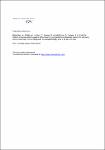Pattern of seroreactivity against feline foamy virus proteins in domestic cats from Germany
Bleiholder, Anne
Mühle, Michael
Hechler, Torsten
Bevins, Sarah
vandeWoude, Sue
Denner, Joachim
Löchelt, Martin
The prevalence of feline foamy virus (FFV, spumaretrovirinae) in naturally infected domestic cats ranges between 30 and 80% FFV positive animals depending on age, sex and geographical region analyzed. Two serotypes have been reported for FFV designated FUV7-like and F17/951-like. Serotype-specific neutralization has been shown to correlate with sequence divergence in the surface (SU) domain of the envelope protein (Env). We analyzed a serum collection of 262 domestic cat sera from Germany using a GST-capture ELISA setup screening for Gag and Bet specific antibodies and identified 39% FFV positive animals. Due to the heterogeneity of the serological samples, cut-offs for Gag and Bet reactivity had to be experimentally determined since application of calculated cut-off values yielded some false-positive results; the new cut-off values turned out to be also fully applicable to a previous study. Using the already established FUV7 ElpSU antigen and the newly cloned and produced F17/951 ElpSU antigen, both consisting of the corresponding ectodomains of the envelope leader protein (Elp) and SU protein, we aimed at the detection of Env-specific antibodies and discrimination between the two known FFV serotypes within the diagnostic FFV ELISA. We validated the ElpSU antigens using cat reference sera of known serotype and screened with this assay domestic cat sera from Germany. Use of the FUV7- and F17/951 ElpSU antigens in ELISA resulted in the detection of Env-specific antibodies in both cat reference sera and sera from domestic cats in Germany, but failed to allow serotyping at the same time.
No license information

